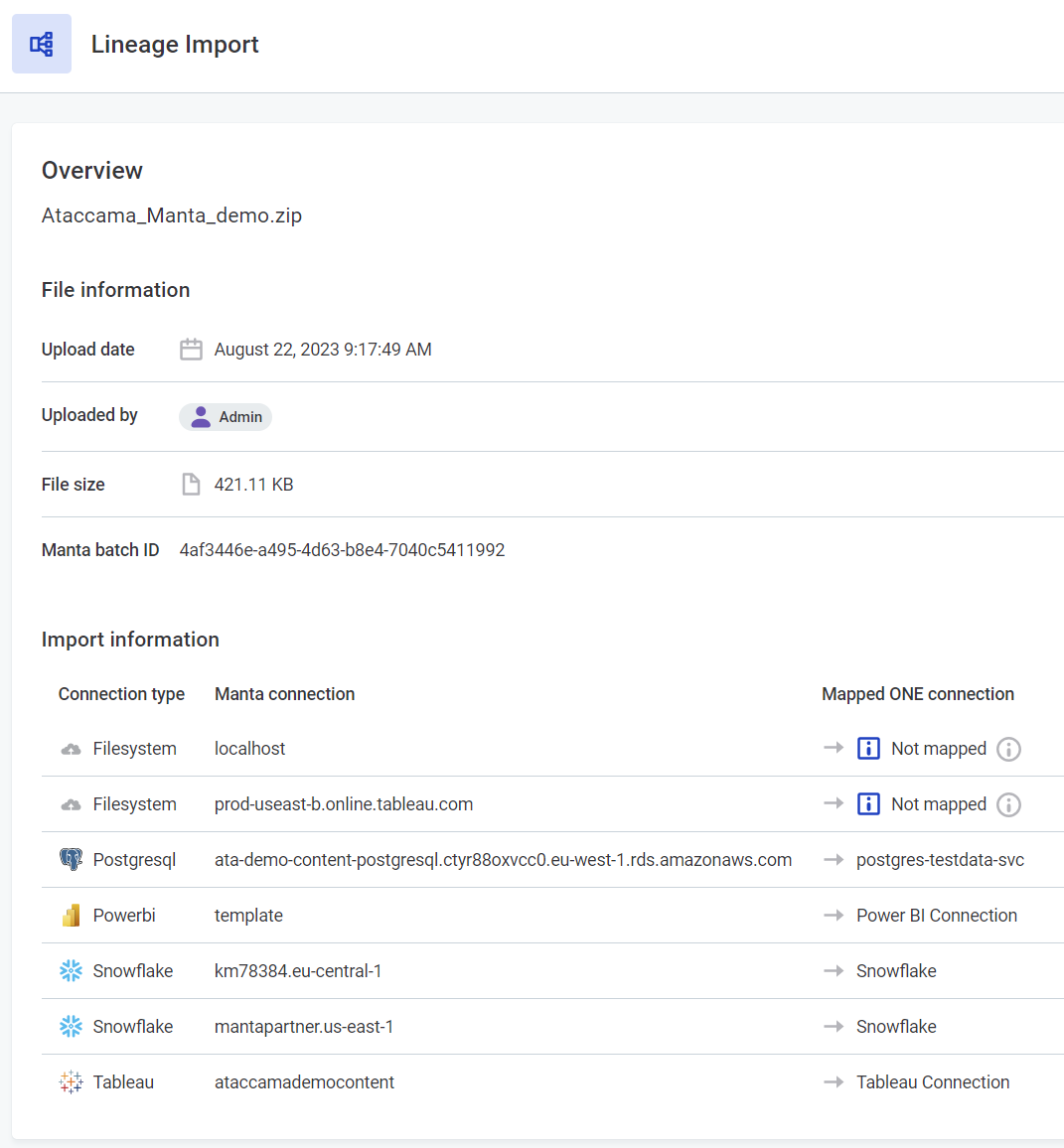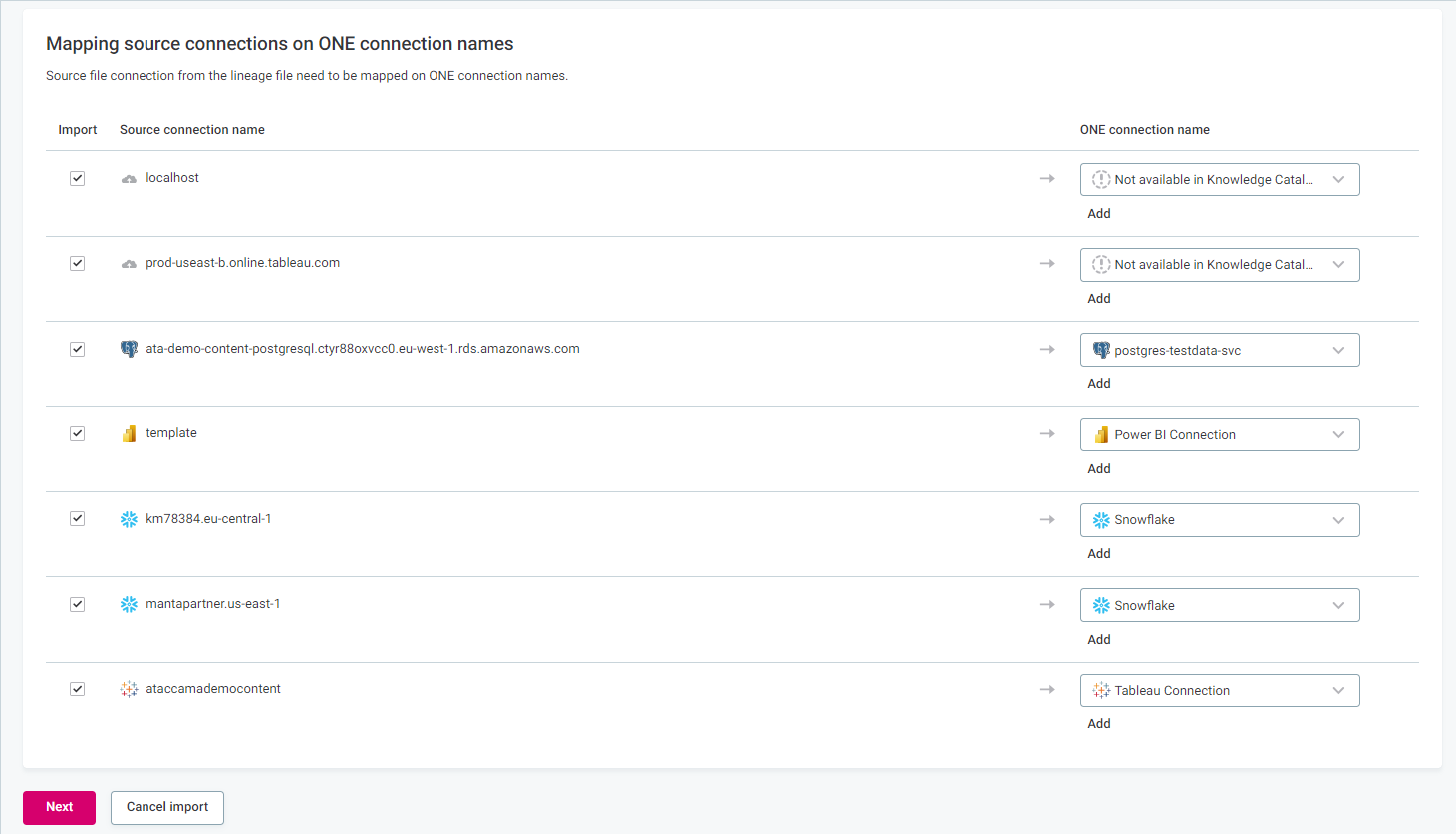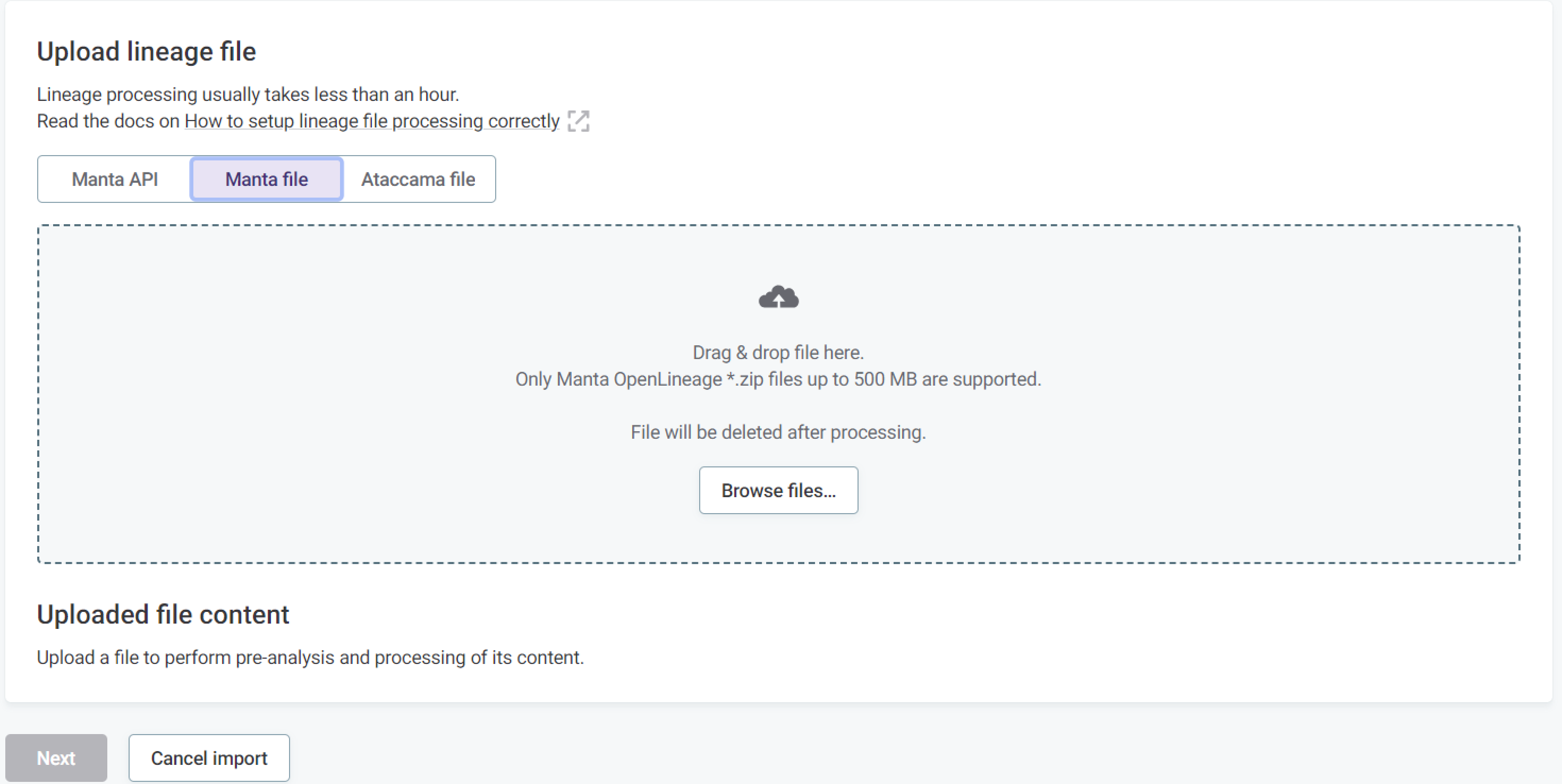Import Lineage
The following topic describes how to import lineage from MANTA.
To work with lineage in ONE, you must first prepare a compatible snapshot of lineage metadata in MANTA. For more information, see Configure MANTA.
To learn more about which connection types are supported, see Lineage.
| The Lineage Import tab is only displayed to users with the ONE Administrator governance role. This setting cannot be changed in the current version. |
Follow the corresponding import procedure depending on the version of ONE you are running. In 14.5.1, you can import lineage using the MANTA API or by uploading an import file (MANTA or Ataccama) manually in ONE.
-
Version 14.5.0
-
Version 14.5.1: Using MANTA API
-
Version 14.5.1: Upload file manually
You can import only MANTA OpenLineage ZIP files of up to 500 MB.
-
In ONE, go to Knowledge Catalog > Lineage Import.
-
Select Import.
-
Drag and drop the lineage ZIP file in the file uploader. For instructions about how to prepare and export this file, see Configure MANTA.
Alternatively, select Browse files and choose the file from your local drive.
-
Check the preprocessing results. If no issues are detected, select Next and wait for the processing to finish.
You can continue using the platform in the meantime and return to the Lineage Import tab later to finish the setup.
If you see an error message instead, verify the content of the uploaded file and your settings in MANTA. If necessary, generate the import file and try again.
-
Map the MANTA dictionaries contained in the lineage file to the corresponding data source connections in ONE. You can also map one dictionary to multiple connections (select Add to include additional connections).
In case you don’t want to import all dictionaries from your import file, clear the Import field as needed.
If ONE doesn’t have a corresponding connector for one of your dictionaries and you still want to import the metadata, map this dictionary to Not available in Knowledge Catalog. In this case, the imported metadata will be shown in your lineage but the nodes cannot be reached or enriched in Knowledge Catalog.
You can also use this mapping if the connection is not yet configured in Ataccama. However, once you set up the connection, you need to import the metadata and map it again.
Take note of the following:
-
Connections are prefiltered based on the identified connection type (technology). If the connection you are looking for is configured but not displayed, select Load more items.
-
To change a selected connection, you need to manually remove the text from the field in the ONE connection name column:
-
Select the connection type you want to change.
-
Place the cursor at the end of the connection name.
-
Remove the text using the backspace key.
-
Select another ONE connection.
-

-
-
Once you’re happy with your configuration, select Next. You can continue using the platform in the meantime.
-
After the import finishes, start exploring the lineage of relevant catalog items.
To view the lineage, open the catalog item detail and switch to the Lineage tab.
You can view a summary of the latest lineage import and mapping on the Lineage Import tab.

You need to perform steps 3-5 only if you’re extracting lineage metadata from your MANTA server for the first time or if you want to change the server you’re importing metadata from.
-
In ONE, go to Knowledge Catalog > Lineage Import.
-
Select Import.
-
Make sure Manta API is selected and open the settings, then provide the following information:
-
Manta Admin UI server URL: The URL where the MANTA Admin interface is available.
-
Keycloak server URL: The Keycloak endpoint used for authorization of the MANTA client.
-
Manta Realm: The MANTA realm name in Keycloak.
-
Client ID used with Manta API: The MANTA client name in Keycloak.
-
Client secret used with the client ID: The MANTA client secret in Keycloak.
-
-
To check whether the connection is correctly configured, select Test Connection. If the connection is successful, continue with the following step.
Otherwise, verify that your configuration is correct and that your MANTA server is running.
Server visibility issues might mean you can’t use the API to extract your lineage metadata from MANTA. This can be caused by firewalls blocking the connection. In these cases, upload your Manta or Ataccama file using the manual method.
-
Select Save.
-
Select a lineage extraction to import.
If you see an error message, ensure that your MANTA server information is correct. -
Select Upload the selected lineage extraction.
-
Once your lineage extraction finishes uploading, select Next and wait for the processing to finish. This might take some time, especially if you’re importing a large amount of data.
You can continue using the platform and return to the Lineage Import tab later once the processing is finished. Your progress is saved automatically.
-
Map the MANTA connection names to the corresponding data source connections in ONE. You can also map individual connection names to multiple connections (select Add to include additional connections).
If you don’t want to import every connection name, clear the Import field as needed.
If ONE doesn’t have a corresponding connector for one of your dictionaries and you still want to import the metadata, map this dictionary to Not available in Knowledge Catalog. In this case, the imported metadata will be shown in your lineage but the nodes cannot be reached or enriched in Knowledge Catalog.
You can also use this mapping if the connection is not yet configured in Ataccama. However, once you set up the connection, you need to import the metadata and map it again.
Take note of the following:
-
Connections are prefiltered based on the identified connection type (technology). If the connection you are looking for is configured but not displayed, select Load more items.
-
To change a selected connection, you need to manually remove the text from the field in the ONE connection name column:
-
Select the connection type you want to change.
-
Place the cursor at the end of the connection name.
-
Remove the text using the backspace key.
-
Select another ONE connection.
-

-
-
Once you’re happy with your configuration, select Next. After your import finishes, choose how the data from your previous lineage imports is handled.
-
Expand: Add lineage information for new catalog items from the new import. Catalog items that exist in both versions of lineage are not changed.
-
Overwrite: All lineage information from previous imports is deleted and replaced with lineage information from the new import.
-
Keep: Keep the current lineage and discard the newly imported one.
Here, for each connection you can see the connection type, the selected mapping in ONE (ONE Connection), the name of the connection in MANTA (Source connection), and the number of catalog items with and without a match. 
-
-
You can now start exploring the lineage of relevant catalog items.
To view the lineage, open the catalog item detail and switch to the Lineage tab.
You can import only MANTA OpenLineage or Ataccama ZIP files of up to 500 MB.
-
In ONE, go to Knowledge Catalog > Lineage Import.
-
Select Import.
-
Select MANTA file or Ataccama file.
-
Drag and drop your lineage file in the uploader. Alternatively, select Browse files and choose the file from your local drive.
For instructions about how to prepare and export a MANTA file, see Configure MANTA.

-
Check the preprocessing results. If no issues are detected, select Next and wait for the processing to finish.
You can continue using the platform in the meantime and return to the Lineage Import tab later once the processing is finished. Your progress is saved automatically.
If you see an error message instead, verify the content of the uploaded file and your settings in MANTA. If necessary, generate the import file and try again.
-
Map the MANTA connection names to the corresponding data source connections in ONE. You can also map individual connection names to multiple connections (select Add to include additional connections).
If you don’t want to import every connection name, clear the Import field as needed.
If ONE doesn’t have a corresponding connector for one of your dictionaries and you still want to import the metadata, map this dictionary to Not available in Knowledge Catalog. In this case, the imported metadata will be shown in your lineage but the nodes cannot be reached or enriched in Knowledge Catalog.
You can also use this mapping if the connection is not yet configured in Ataccama. However, once you set up the connection, you need to import the metadata and map it again.
Take note of the following:
-
Connections are prefiltered based on the identified connection type (technology). If the connection you are looking for is configured but not displayed, select Load more items.
-
To change a selected connection, you need to manually remove the text from the field in the ONE connection name column:
-
Select the connection type you want to change.
-
Place the cursor at the end of the connection name.
-
Remove the text using the backspace key.
-
Select another ONE connection.
-

-
-
Once you’re happy with your configuration, select Next. After your import finishes, choose how the data from your previous lineage imports is handled.
-
Expand: Add lineage information for new catalog items from the new import. Catalog items that exist in both versions of lineage are not changed.
-
Overwrite: All lineage information from previous imports is deleted and replaced with lineage information from the new import.
-
Keep: Keep the current lineage and discard the newly imported one.
Here, for each connection you can see the connection type, the selected mapping in ONE (ONE Connection), the name of the connection in MANTA (Source connection), and the number of catalog items with and without a match. 
-
-
You can now start exploring the lineage of relevant catalog items.
To view the lineage, open the catalog item detail and switch to the Lineage tab.
Was this page useful?
